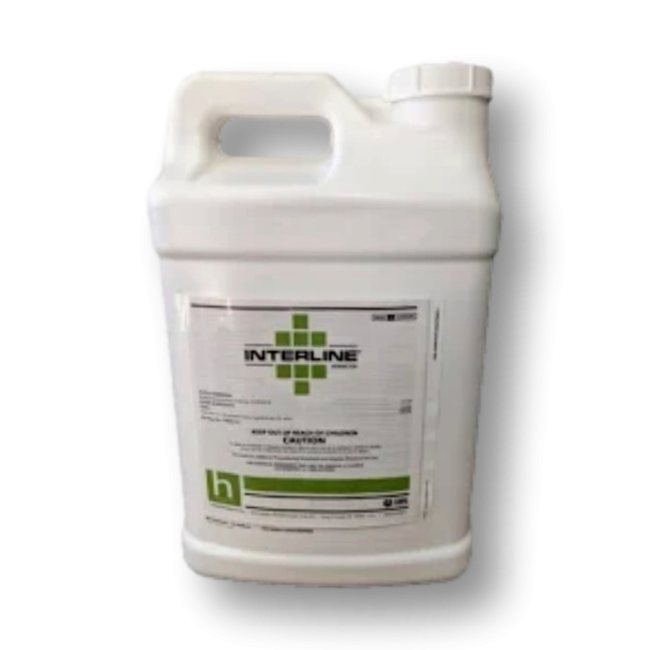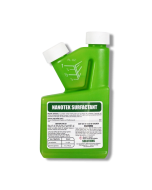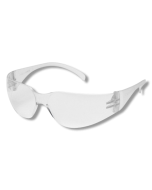Gain access to personalized product screening, the best pricing, rewards, and more!



application2
Interline Herbicide
Interline Herbicide is a rapid non-selective herbicide that provides broad-spectrum weed control in a variety of crops.
12/24/25
Interline Herbicide, manufactured by United Phosphorous, is an effective non-selective herbicide that quickly eliminates hard-to-manage grass and broadleaf weeds including those resistant to glyphosate.
Flexible use patterns of this product as either a burn-down treatment for a brand new crop planting season or over-the-top sprays in current crops allows easy use for commercial property owners.
Interline Herbicide is a unique mode of action herbicide that delivers weed control flexibility and proven performance with a low application rate per acre.
Tools Needed
To apply Interline Herbicide, you will need to use either a backpack sprayer, handheld pump sprayer, or spray rig.
How to Use
- Step 1: Determine how much Interline Herbicide to use by measuring the square footage of the treatment area. To do this, measure the length and width of the treatment area in feet then multiply them together (length X width = square footage). For acreage, take the square footage and divide it by one acre (square footage / 43,560 sq. ft. = acres). For farmstead areas, use 48-82 fl. oz. of Interline Herbicide per 80 gallons of water per acre. For spot treatments in public and recreational areas, apply 56-82 fl. oz. of product in 80 gallons of water per acre. For applications in conservation reserve programs (crp), use 48-56 fl. oz. of product in 80 gallons of water per acre. Refer to the label for specific application rates and restrictions.
- Step 2: Fill the spray tank with half the amount of water, add measured amount of Interline Herbicide, and then pour in the remaining half of water. Close the spray tank lid and shake it until solution has dissolved in water.
- Step 3: Spray Interline Herbicide directly to the underside of undesirable vegetation foliage until wet but not to the point of runoff. Make sure the enter underside of weed leaves are wet.
Where to Use
Use Interline Herbicide on weeds within labeled row crops; and as over-the-top applications in canola, corn, cotton, soybeans and sugar beets designated as glufosinate-resistant
It may also be used on the following military, private, and public lands such as, but not limited to: access roads, airfields, airports, alleys, along fences, around commercial or industrial structures or outbuildings, around farm and ranch structures and outbuildings, around ornamental gardens, around ornamental trees and shrubs (including Christmas trees), bare ground, barrier strips, beaches, campgrounds, canals, Conservation Reserve Program (CRP), construction sites, ditch banks, drive-in theaters, driveways, dry ditches, fencerows, firebreaks, fuel storage areas, golf courses (excluding greens, tees, aprons, fairways, and roughs), gravel yards, greenhouses, habitat restoration and management areas, highways and roadsides (including aprons, medians, guardrails, and right of ways), industrial areas, industrial plant sites, landscapes, and lanes.
When to Use
Apply Interline Herbicide when weeds are small or at a height of 3 inches and on days when rainfall is not expected to occur at least 4 hours after application.
To maximize weed control, do not cultivate from 5 days before an application to 7 days after an application.
Safety Information
Interline Herbicide is safe to use around children and pets when applied according to the product label instructions. Always wear the proper personal protective equipment (PPE) when mixing and applying this product.
Keep people and pets out of treated areas for at least 24 hours after application.
Canola, field corn, and soybean scouting will need people and pets to stay out for 4 days after application.
Special Considerations
Post emergence row crop applications of Interline herbicide may be made only to crops resistant to glufosinate. The basis of selectivity of INTERLINE herbicide in glufosinate-resistant crops is the presence of a gene that makes crops not sensitive to glufosinate.
Crops not containing this glufosinate-resistant gene will be sensitive to this product and severe crop injury and/or death may occur. Do not allow spray to contact foliage or green tissue of desirable vegetation other than containing the glufosinate-resistant trait.
| Restricted Use | No |
|---|---|
| Shipping Restrictions | AK, DC, KS |
| Availability | Online |
| Signal Word | CAUTION |
| Keith's Pro Tip | “When making applications in hot and dry conditions, set up equipment to produce larger droplets to reduce effects of evaporation.” |
| Time to Kill | Interline Herbicide will kill weeds within 2-4 days after application. |
| Chemical Type | Herbicide |
| Formulation | Suspended Concentrate |
| Application Methods | Spot Treatment |
| Product Drawbacks | Interline Herbicide will completely burn down and kill any foliage it comes into contact with including desirable ornamentals. |
| Active Ingredient | Glufosinate-ammonium 24.5% |
| Application Equipment | Backpack Sprayer, Pump Sprayer, Spray Rig |
| Mix Rate | For farmstead areas, use 48-82 fl. oz. of Interline Herbicide per 80 gallons of water per acre. For spot treatments in public and recreational areas, apply 56-82 fl. oz. of product in 80 gallons of water per acre. For applications in conservation reserve programs (crp), use 48-56 fl. oz. of product in 80 gallons of water per acre. |
| Use Sites | Outdoors |
| Yield | 2.5 Gallons of Interline Herbicide will cover approximately 8 acres. |
| EPA Registration No. | 70506-310 |
| Shelf Life | Interline Herbicide will last up to 3 years when stored in a dry, clean site. |
| Comparable Products | Surmise Pro Herbicide |
| Children or pets? | No |
| Property Characteristics | None |
| Availability | Online |
| Restricted Use | No |
| Brand | UNITED PHOSPHORUS |
| Keith's Pro Tips | “When making applications in hot and dry conditions, set up equipment to produce larger droplets to reduce effects of evaporation.” |
| Product Drawbacks | Interline Herbicide will completely burn down and kill any foliage it comes into contact with including desirable ornamentals. |
| Target Pests | Alfalfa, Alsike clover, Annual bluegrass, Annual fleabane, Annual marshelder, Annual ryegrass, Annual sowthistle, Barnyardgrass, Bermudagrass, Biennial wormwood, Black medic, Black nightshade, Bristly foxtail, Bristly starbur, Broadleaf signalgrass, Buffalobur, Bull thistle, Bulrush, Burcucumber, Burdock, California arrowhead, California burclover, Canada thistle, Canarygrass, Canola, Carolina horsenettle, Carpetweed, Catchweed bedstraw, Chinese thornapple, Cleavers, Coffee senna, Common chickweed, Common cocklebur, Common groundsel, Common lambsquarters, Common mallow, Common milkweed, Common mullein, Common purslane, Common ragweed, Common sunflower, Common waterhemp, Common yarrow, Corn, Cudweed, Curly dock, Cutleaf eveningprimrose, Cutleaf geranium, Cutleaf groundcherry, Dallisgrass, Dandelion, Devils claw, Dodder, Downy brome, Eastern black nightshade, Eclipta, Entireleaf morningglory, Fall panicum, Fescue, Fiddleneck, Field bindweed, Field horsetail, Field sandbur, Filaree, Florida beggarweed, Florida pusley, Giant foxtail, Giant ragweed, Goosefoot, Goosegrass, Gray goldenrod, Green foxtail, Gromwell, Guineagrass, Hairy galinsoga, Hairy nightshade, Hedge bindweed, Hemp dogbane, Hemp sesbania, Hempnettle, Henbit, Honeyvine milkweed, Hophornbeam copperleaf, Ivyleaf morningglory, Java bean, Jerusalem artichoke, Jimsonweed, Johnsongrass, Johnsongrass (seedling), Junglerice, Kentucky bluegrass, Knotweed, Kochia, Ladysthumb, Large crabgrass, Leafy spurge, Little mallow, London rocket, Lovegrass, Malva, Marestail, Marshelder, Mayweed, Miners lettuce, Mouseear chickweed, Mugwort, Musk thistle, Nettle, Orchardgrass, Palmer amaranth, Panicle willoweed, Paragrass, Pennsylvania smartweed, Pennycress, Perennial sowthistle, Pineappleweed, Pitted morningglory, Plantain, Poison ivy, Poison oak, Pokeweed, Prairie sunflower, Prickly lettuce, Prickly sida, Prostrate pigweed, Prostrate spurge, Puncturevine, Purple ammania, Purple nutsedge, Quackgrass, Red clover, Red rice, Redmaids, Redroot pigweed, Redstem filaree, Ripgut brome, Robust purple foxtail, Rubus species, Russian thistle, Sharppod morningglory, Shattercane, Shepherdspurse, Sicklepod, Silverleaf nightshade, Smallflower galinsoga, Smallflower morningglory, Smell melon, Smooth bromegrass, Smooth crabgrass, Smooth dock, Smooth pigweed, Soft chess, Soybean, Spiny pigweed, Spotted spurge, Sprangletop, Spurred anoda, Stinkgrass, Stinkweed, Swinecress, Tall morningglory, Tall waterhemp, Tansymustard, Texas blueweed, Texas panicum, Timothy, Toad rush, Torpedograss, Tropic croton, Tumble pigweed, Turkey mullein, Vaseygrass, Velvetleaf, Venice mallow, Vervain, Vetch, Virginia copperleaf, Volunteer barley, Volunteer corn, Volunteer cotton, Volunteer proso millet, Volunteer rice, Volunteer sorghum, Volunteer soybean, Volunteer sunflower, Volunteer wheat, White clover, Whiteheath aster, Wild buckwheat, Wild mustard, Wild oat, Wild onion, Wild poinsettia, Wild proso millet, Wild radish, Wild rose, Wild turnip, Windgrass, Wirestem muhly, Witchgrass, Woodsorrel, Woolly croton, Woolly cupgrass, Woollyleaf bursage, Yellow foxtail, Yellow nutsedge, Yellow rocket, and Yellow starthistle. |
| Application Equipment | Backpack Sprayer, Pump Sprayer, Spray Rig |
| Application Methods | Spot Treatment |
| Active Ingredient | Glufosinate-ammonium 24.5% |
| Product Type | Herbicide |
| Formulation | Suspended Concentrate |
| Application Rate | For farmstead areas, use 48-82 fl. oz. of Interline Herbicide per 80 gallons of water per acre. For spot treatments in public and recreational areas, apply 56-82 fl. oz. of product in 80 gallons of water per acre. For applications in conservation reserve programs (crp), use 48-56 fl. oz. of product in 80 gallons of water per acre. |
| Shelf Life | Interline Herbicide will last up to 3 years when stored in a dry, clean site. |
| Yield | 2.5 Gallons of Interline Herbicide will cover approximately 8 acres. |
| Use Sites | Outdoors |
| Time to Kill | Interline Herbicide will kill weeds within 2-4 days after application. |
| Comparable Products | Surmise Pro Herbicide |
| Use Caution With | Bentgrass, Bermudagrass, Kentucky Bluegrass, Fescue, Fine, Fescue, Tall, Kikuyugrass, Ryegrass, St Augustine, Zoysiagrass |
| EPA Registration # | 70506-310 |
*Price does not include freight. We guarantee our rate plus shipping will be less than anyone else's price.










